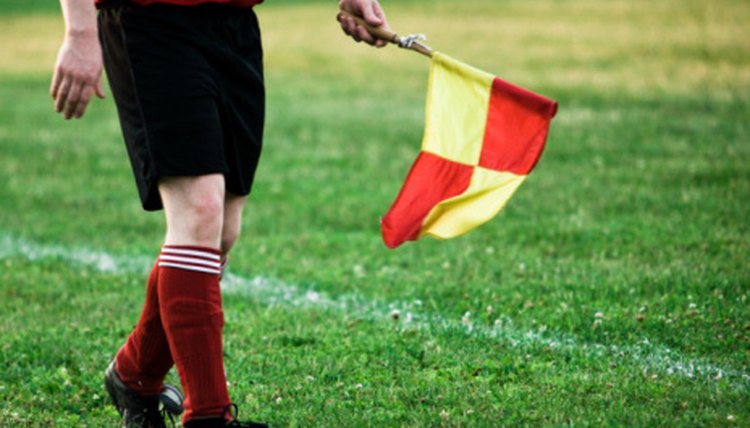The Duties of a Soccer Linesman

In 1891, soccer referees moved from the touchlines onto the field of play. This brought about a new development: the introduction of a linesman, or assistant referee, on each touchline. The linesman’s role has remained fundamentally the same since that time. It is his duty to assist and advise the referee from the touchline, with a particular focus on specific aspects of the game.
Ball Out of Play
The linesman decides when the ball has gone out of play. She is able to look directly along both the touchline and goal line, something that the referee is normally unable to do. When the whole of the ball has left the field, the linesman raises her flag to signal the need for a throw-in, goal kick or corner kick.
Set Piece Decisions
When the ball leaves the field of play, the linesman decides which team is entitled to the ensuing throw-in, goal kick or corner kick. As with all other refereeing decisions, the referee himself has the final word and can overturn the linesman’s decision if deemed necessary.
Offside Decisions
The linesman raises his flag when he spots a player in an offside position. This is one of his most difficult tasks. It often involves a split-second decision in a potentially match-winning situation.
Substitutions
When a manager or coach wants to make a substitution, she will inform the linesman in charge of the touchline closest to the team dugout or technical area. It is then the linesman’s duty to inform the referee of the requested change.
Unseen Incidents
Keeping one eye on 22 players is an impossible task for the referee. The linesman, therefore, acts as a second pair of eyes. It is his duty to indicate when an incident occurs out of the referee’s view. According to the Football Referee website, the referee is expected to act on the linesman’s advice regarding incidents that he did not witness himself.
Better View
If the referee believes the linesman had a better view of an incident, she will consult with the linesman to determine the correct course of action.
Penalty Kicks
The linesman has two key duties during penalty kicks, both of which involve looking along the goal line. He must first decide whether the goalkeeper moved off the goal line before the penalty-taker kicked the ball. He must then decide whether the whole ball crossed the goal line.
Entering the Field of Play
Linesmen rarely enter the field of play, remaining on the touchline for most of the game. If needed, a linesman can enter the field of play to assist the referee during free kick procedures, specifically to help enforce the 10 yards law. Linesmen also help the referee when scuffles or fights occur. According to the FIFA Laws of the Game, the nearest assistant referee may enter the field of play to assist the referee in situations of mass confrontation.
References
Writer Bio
Anthony Grahame has been a writer for more than 15 years. He began writing professionally online in 2008. He has a degree in English literature from the University of Sussex and is an experienced traveler and travel writer. His work has been published on a variety of well respected websites including "Living in Peru".
